The Seagate Enterprise Capacity 6TB V.4 is billed as the “world’s fastest” nearline HDD currently on the market, with claims of performance 25% over competitive offerings. With an operating speed of 7200RPM, the Seagate V.4 also comes in 5TB, 4TB and 2TB flavors. Each type can be purchased with either 12Gb/s SAS or 6Gb/s SATA connectivity, allowing it to be easily integrated into current systems. Seagate also supports optional SED and FIPS encryption.
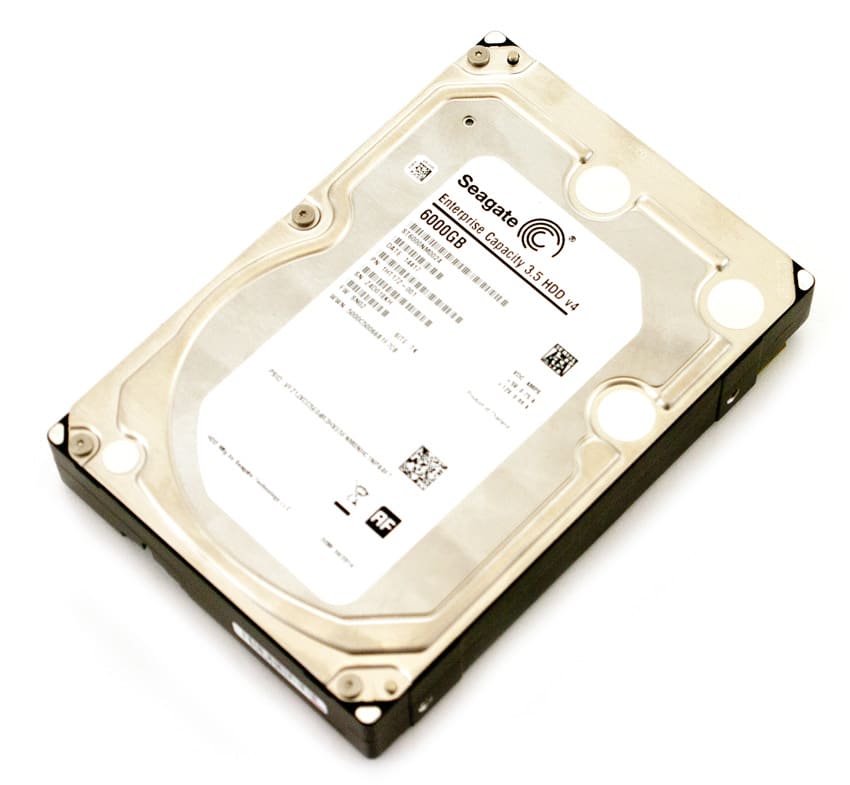
High quality and reliable storage needs are exploding to new levels. While companies can continue to add 4TB HDDs there is an upper limit to the amount that can be added to an existing network. With the Seagate 6TB V.4, users can add 50% additional storage into the same rack U space. Not only will users get 2TB of extra space per HDD in a given footprint, users can choose from SED or government-grade SED FIPS 140-2 all with Seagate’s Instant Secure Erase technology. Built on field-proven, eighth-generation platforms, the Seagate Enterprise Capacity 6TB V.4 is made to deliver high capacity storage, 24×7 reliable storage without sacrificing performance
The Seagate Enterprise Capacity 6TB 3.5 HDDv4 comes with a 5-year limited warranty and has a street price of about $600.00 at the time of this review. Our review comprises 16 of the 6TB drive with SATA interface.
Seagate Enterprise Capacity 6TB 3.5 HDD Specifications:
- Model
- SAS: ST6000NM0014, ST6000NM0034, ST6000NM0054, ST6000NM0104
- SATA: ST6000NM0004, ST6000NM0024, ST6000NM0044, ST6000NM0084
- Interface: SAS 12Gb/s, SATA 6Gb/s
- Capacity (GB): 6TB
- Sector size (variable, Bytes/sector): 512/4096
- Max Areal Density (Gbits/sq. in.): 643/633
- Form Factor: 3.5-inch HDD
- Performance:
- Rotational Speed (RPM):7200
- Interface Access Speeds (Gb/s): 12.0, 6.0, 3.0 (SAS), 6.0, 3.0, 1.5 (SATA)
- Reliability:
- Error Rate (non-recoverable, bits read): 1 in 10^15
- MTBF (M hours): 1.4
- Availability (hrs/day x days/wk): 24×7
- Reliability – Warranty (yrs): 5
- Power
- Requirement: +5 VDC and +12VDC
- Typical Operating, Random Read (W): 11.86 (SAS), 11.27 (SATA)
- Idle (W, avg): 7.97 (SAS), 6.9 (SATA)
- Physical size
- Dimensions (H x W x D, mm): 26.1 x 101.85 x 147.0
- Weight (g): 780
- Environmental (operating)
- Ambient temperature: 5º to 60º C
- Shock (half-sine wave): 70
- Environmental (non-operating)
- Shock (half-sine wave): 250
- Vibration (10 to 500 Hz): 5.0 (SATA), 4.9 (SAS)
Design And Build
The Seagate Enterprise Capacity 6TB hard drives have a similar appearance to standard counterparts. The drives aren’t flashy; they are functional. The top of the drive is all silver with an inlay in the center adding protection to the drive head. Also featured on the top, there are six screws enabling access to the internal parts of the drive.
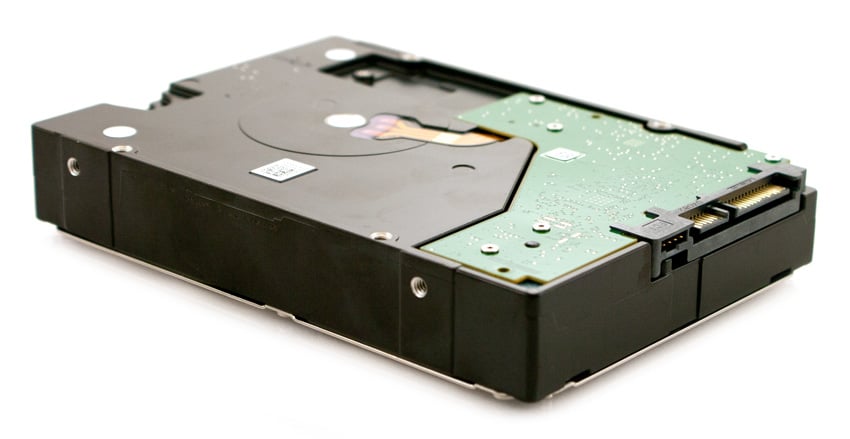
Most notable from a design perspective is that to make room for the sixth platter, Seagate had to move the center screw holes. They’re gone on the sides entirely, and the ones on the bottom have moved to the back. There’s a chance this could make the drives incompatible with tool-less drive trays and older trays that have not accounted for the move to a rear mounting point on the bottom of the drive.
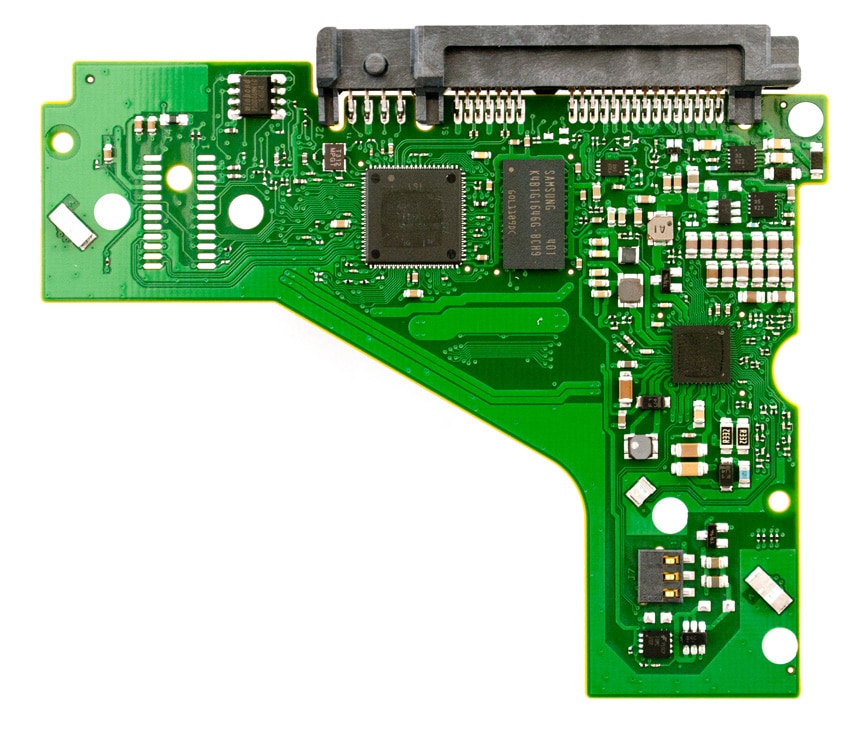
Testing Background and Comparables
For our testing we used 16 x SATA Seagate 6TB HDDs.
Enterprise HDD comparables for this review:
- Seagate Constellation ES.2 3TB
- HGST Ultrastar He6 6TB
- Western Digital RE4 4TB
- Seagate Constellation CS 3TB
- Western Digital Se 4TB
All enterprise HDDs are benchmarked on the same testing platform for each test.
For our Synthetic FIO tests, we use our ThinkServer RD240 configured with:
- 2 x Intel Xeon X5650 (2.66GHz, 12MB Cache)
- Windows Server 2008 Standard Edition R2 SP1 64-Bit and CentOS 6.2 64-Bit
- Intel 5500+ ICH10R Chipset
- Memory – 8GB (2 x 4GB) 1333Mhz DDR3 Registered RDIMMs
- LSI 9211 SAS/SATA 6.0Gb/s HBA
Application tests each have a unique environment that is detailed on each benchmark page. For cases where 16 drives are tested, an iXsystems Titan 316J JBOD was added to the environment and connected to the relevant cluster via external SAS cable.
Application Performance Analysis
In the enterprise market, there is a huge difference between how products claim to perform on paper and how they perform in a live production environment. We understand the importance of evaluating storage as a component of larger systems, most importantly how responsive storage is when interacting with key enterprise applications. To this end, we’ve rolled out application tests including our MySQL performance via SysBench and SQL Server performance via Benchmark Factory.
Our first application test consists of Percona MySQL database test via SysBench, which measures the performance of OLTP activity. In this testing configuration, we use a group of Lenovo ThinkServer RD630s and load a database environment onto a single SATA, SAS or PCIe drive or a group of HDDs using an LSI 9286-8e RAID card. This test measures average TPS (Transactions Per Second), average latency, as well as average 99th percentile latency over a range of 2 to 32 threads. Percona and MariaDB are using the Fusion-io flash-aware application APIs in the most recent releases of their databases, although for the purposes of this comparison we test each device in their “legacy” block-storage modes.
With a working database footprint of about 333GB, we looked at the performance in both RAID10 using the Seagate Enterprise Capacity 6TB. The Seagate 6TB ran a little on the lower end to middle here, peaking at 332.34TPS, outperforming the WD RE4 and Se comparables.
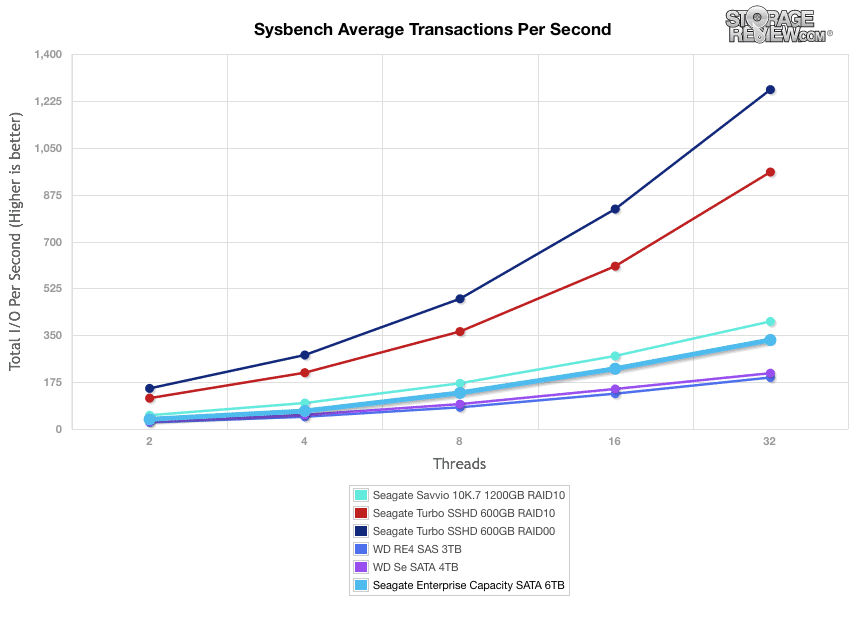
Measuring average latency in our Sysbench MySQL test, the Seagate 6TB out performed both of the WD drives with lower average latency.
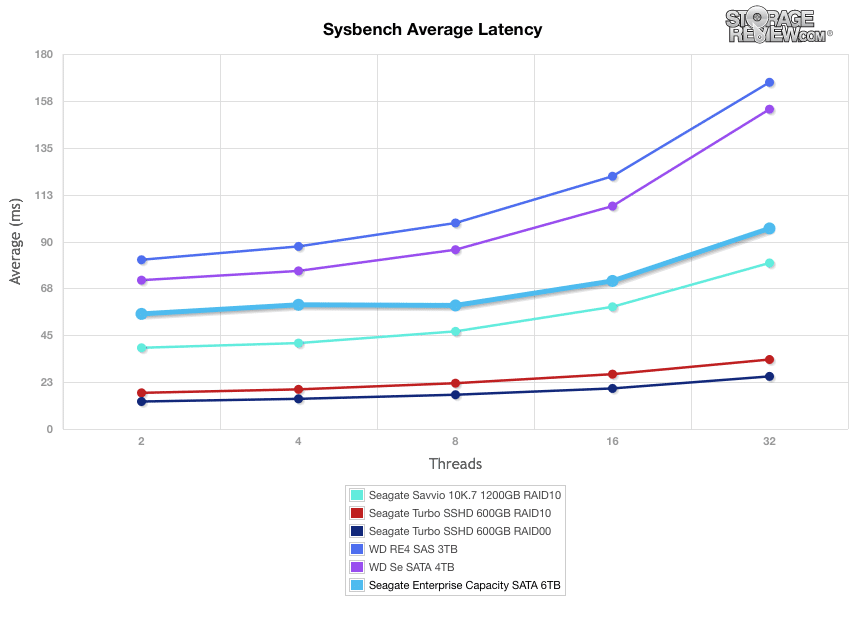
Comparing the 99th percentile latency in during the TPC-C Sysbench test, similar results to those above can bee seen with the Seagate 6TB running better than the WD SAS and SATA comparables.
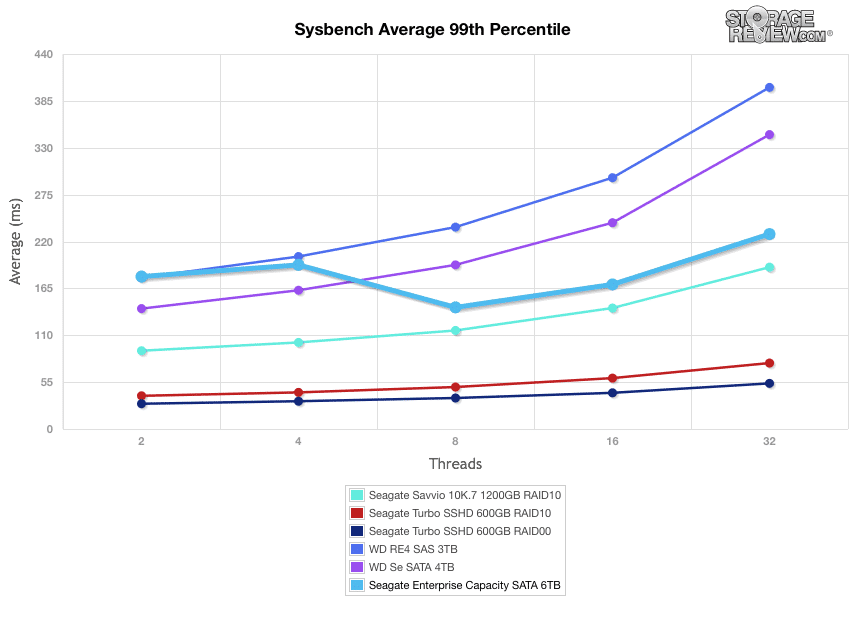
StorageReview’s Microsoft SQL Server OLTP testing protocol employs the current draft of the Transaction Processing Performance Council’s Benchmark C (TPC-C), an online transaction processing benchmark that simulates the activities found in complex application environments. The TPC-C benchmark comes closer than synthetic performance benchmarks to gauging the performance strengths and bottlenecks of storage infrastructure in database environments. For this test, our SQL Server protocol uses a 333GB (1,500 scale) SQL Server database and measures the transactional performance and latency under a load of 15,000 virtual users.
Looking at the transactional performance of each drive configuration, the Seagate 6TB holds its own coming in at just under 3,000TPS again beating out the WD drives and closely trailing the Seagate Savvio 10K.7 drives.
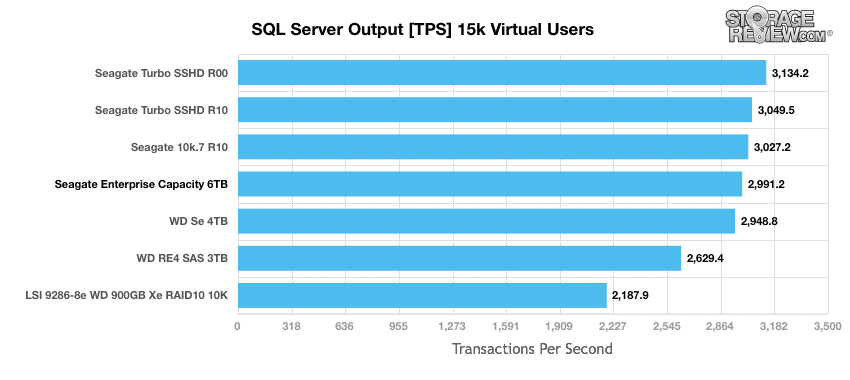
Comparing average latency between each storage configuration, we once again see similar results.
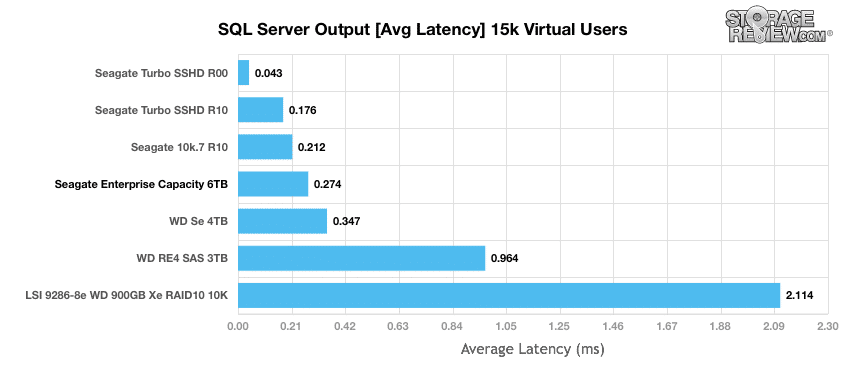
Enterprise Synthetic Workload Analysis
Our enterprise hard drive benchmark process preconditions each drive into steady-state with the same workload the device will be tested with under a heavy load of 16 threads with an outstanding queue of 16 per thread, and then tested in set intervals in multiple thread/queue depth profiles to show performance under light and heavy usage. Since hard drives reach their rated performance level very quickly, we only graph out the main sections of each test.
Preconditioning and Primary Steady-State Tests:
- Throughput (Read+Write IOPS Aggregate)
- Average Latency (Read+Write Latency Averaged Together)
- Max Latency (Peak Read or Write Latency)
- Latency Standard Deviation (Read+Write Standard Deviation Averaged Together)
Our Enterprise Synthetic Workload Analysis includes four profiles based on real-world tasks. These profiles have been developed to make it easier to compare to our past benchmarks as well as widely-published values such as max 4K read and write speed and 8K 70/30, which is commonly used for enterprise drives.
- 4K
- 100% Read or 100% Write
- 100% 4K
- 8K 70/30
- 70% Read, 30% Write
- 100% 8K
- 128K (Sequential)
- 100% Read or 100% Write
- 100% 128K
In the first of our enterprise workloads, we measured a long sample of random 4k performance with 100% write and 100% read activity to get our peak sustained random I/O results. The Seagate Enterprise Capacity 6TB came out on top in both write and read performance with 234IOPS and 155IOPS respectively.
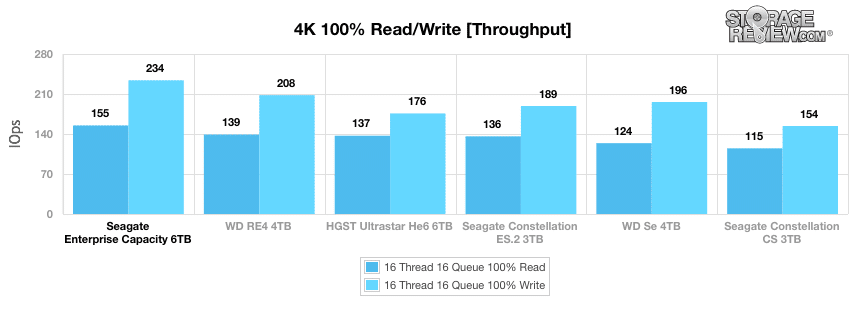
In our main average latency segment with a load of 16T/16Q, again the Seagate 6TB out performed the others having the lowest write and read average latency, at 1090.56ms and 1644.29ms, respectively
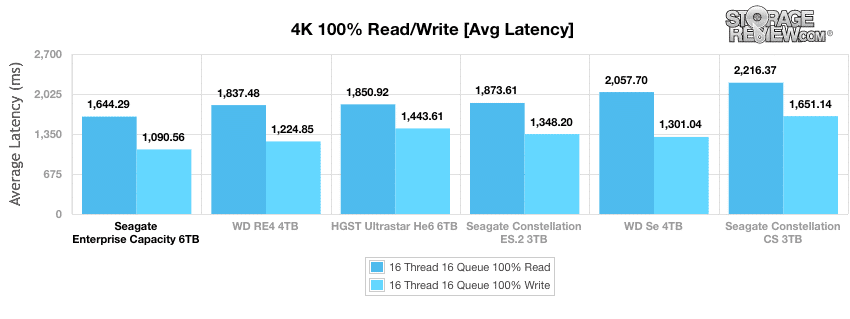
Measuring just read activity, the Seagate 6TB fell to third in max latency with a read speed of 5172ms. Both the Western Digital Se 4TB and the HGST Ultrastar He6 6TB beat it out but only by about 60ms. On the other hand it came in best with write max latency having a speed of 2589ms.
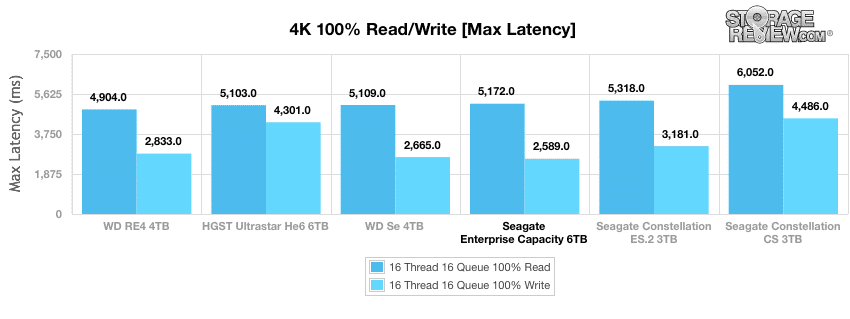
Reviewing the 4k latency consistency in our standard deviation section, the Seagate 6TB had the best read speed at 479.3ms however with a write speed of 130.5ms it dropped to fourth behind the Western Digital Se 4TB, the Western Digital RE4 4TB, and the Seagate Constellation ES.2.
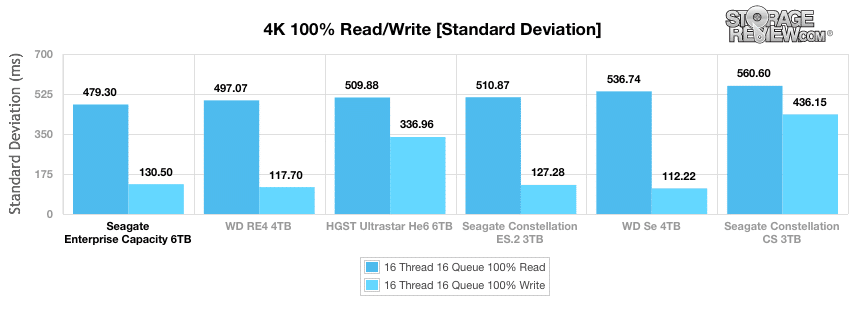
Compared to the fixed 16 thread, 16 queue max workload we performed in the 100% 4k write test, our mixed workload profiles scale the performance across a wide range of thread/queue combinations. In these tests, we span workload intensity from 2 threads and 2 queue up to 16 threads and 16 queue. In the expanded 8k 70/30 test, the Seagate 6TB had the greatest throughput throughout peaking at 214IOPS.
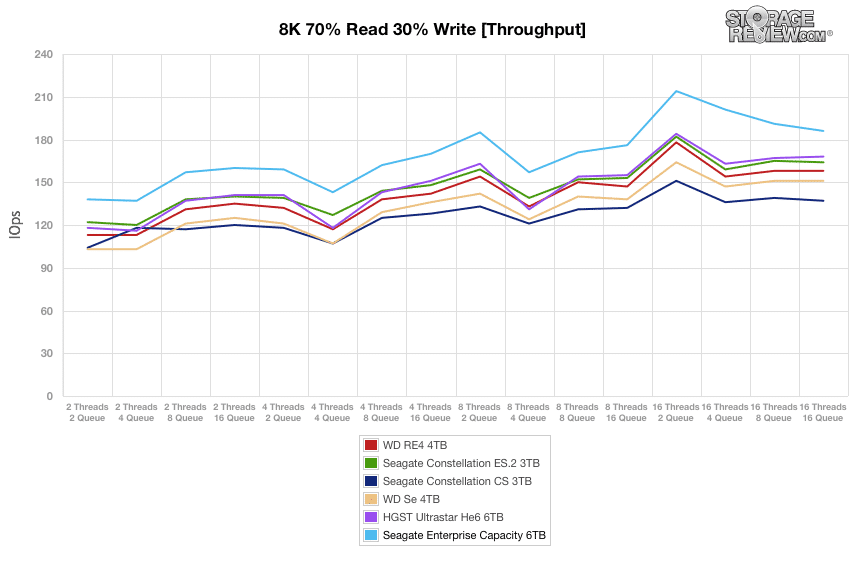
Looking over the 8k 70/30 average response times, the Seagate 6TB had the lowest latency throughout coming out on top again.
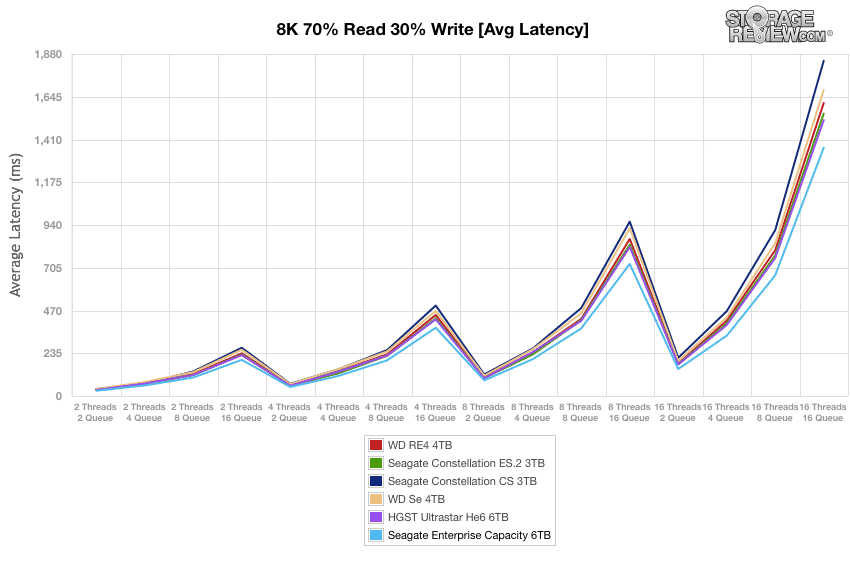
Over the duration of our primary tests at varying thread and queue depth levels, the Seagate 6TB ran near the top of the pack throughout and had the lowest average max latency speed of all HDDs.
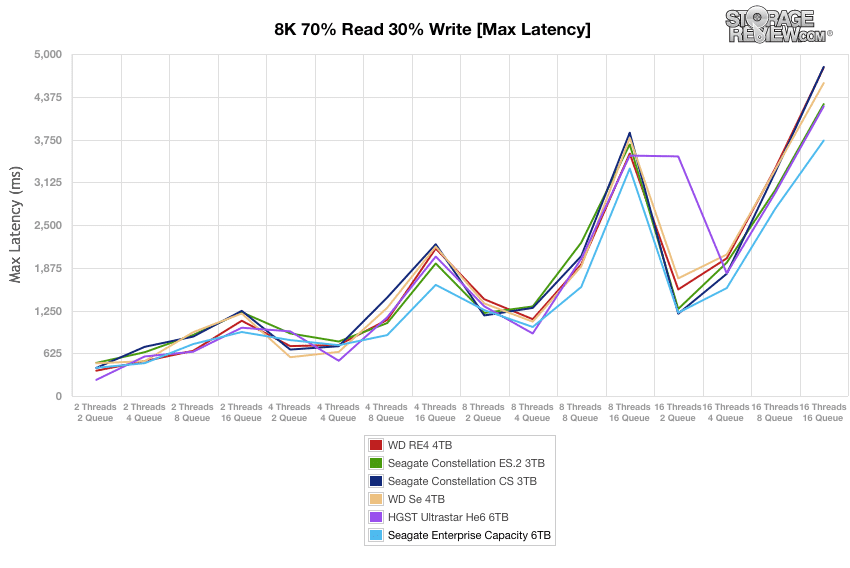
For the entirety of the thread/queue spectrum, the Seagate 6TB had the lowest speeds almost throughout the entire run and had the lowest average.
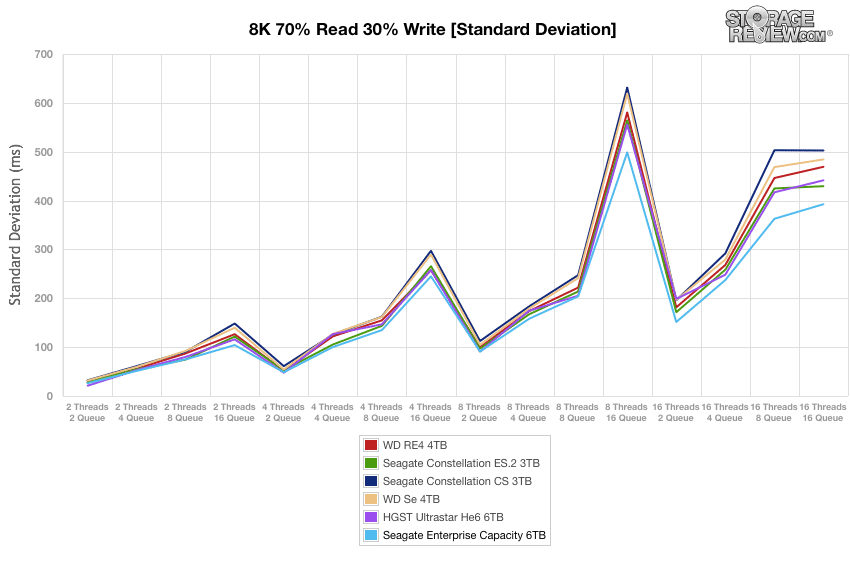
Our Enterprise Synthetic Workload 128K test is a large block sequential test that shows the highest sequential transfer speed for a platter drive. Looking at 128K performance of 100% write and 100% read activity, the Seagate 6TB boasted impressive numbers with 223,053KB/s read and 222,666KB/s write, taking top spot in both categories well ahead of the other HDDs.
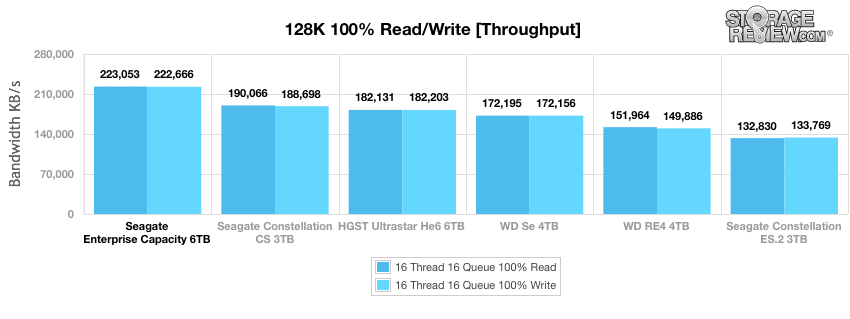
Conclusion
The Seagate Enterprise Capacity 6TB V.4 is a 3.5” HDD with 7200 RPM spindle and Seagate’s proven reliability. It comes in multiple models including other capacity such as 5TB, 4TB, and 2TB with either 12Gb/s SAS or 6Gb/s SATA connectivity for easy integration. The drive is FIPS SED certified for maximum security. The Seagate Enterprise Capacity 6TB V.4 3.5” HDD is ideal for business that want to increase their overall capacity while staying within the same footprint.
Overall we saw the Seagate Enterprise Capacity 6TB perform strong in our enterprise testing and ran strong against similar HDDs in our application performance analysis. In our 4K random performance, the Seagate 6TB came out on top with 234IOPS write and 155IOPS read. It also had the greatest throughput in our 8K 70/30 test. And overall the Seagate had the lowest average latency of the drives tested. In our 128K synthetic workload the Seagate 6TB put out some pretty impressive numbers with 223MB/s in both read and write putting it at the top of the group.
The 6TB world is pretty thin, only HGST ships a competing product that is also available with SATA or SAS interface. The problem for HGST though, is that today their platform is new technology, which means unproven. Seagate has gone with a traditional design and is also significantly faster and less expensive by a wide margin. The helium drive has a power draw benefit, but it’s generally outclassed by Seagate in most use cases. HGST’s decision to go with sealed drive technology may tilt back in their favor when they’re able to go to 8TB and 10TB on this platform, but that’s an argument for another day. Today, if you need 6TB and want the fastest and least expensive, Seagate is the clear winner.
Pros
- Fantastic application performance in MySQL and SQL Server workloads
- Tops the charts in synthetic performance with a clear lead in sequential transfers
- Sticks with traditional and also trusted non-sealed design
- Priced lower than HGST Helium
Cons
- Draws more power than HGST Helium 6TB model
The Bottom Line
The Seagate Enterprise Capacity 6TB 3.5 HDDv4 is a well performing high capacity drive, a drive that can add up to an additional 50% capacity over current drives with a relatively low price point and all the interface and security features the enterprise wants.
Seagate Enterprise Capacity 6TB Product Page
Seagate Enterprise Capacity 6TB at Amazon



 Amazon
Amazon